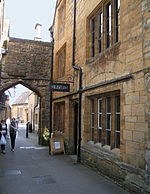Frogden Quarry
Dorset geography stubsEnglish Site of Special Scientific Interest stubsGeology of DorsetQuarries in DorsetSites of Special Scientific Interest in Dorset ... and 2 more
Sites of Special Scientific Interest notified in 1954Use British English from February 2023
Frogden Quarry (grid reference ST649183) is a 0.2 hectare geological Site of Special Scientific Interest in Dorset, England, notified in 1954, by geologist Benjamin Starr. It exposes rocks of the Inferior Oolite, of Aalenian and Bajocian age. The sequence largely consists of limestone, with some marl and siltstone.
Excerpt from the Wikipedia article Frogden Quarry (License: CC BY-SA 3.0, Authors).Frogden Quarry
Underdown Lane,
Geographical coordinates (GPS) Address Nearby Places Show on map
Geographical coordinates (GPS)
| Latitude | Longitude |
|---|---|
| N 50.96305 ° | E -2.50118 ° |
Address
Underdown Lane
Underdown Lane
DT9 4JU , Castleton
England, United Kingdom
Open on Google Maps










